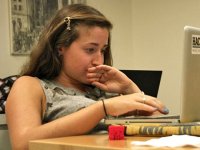Modeling Constructive Online Behavior
As teens construct their digital footprint, model thoughtful use of Facebook, Twitter, LinkedIn, and blogging to help them stand out to college admission officers and potential employers.
Plenty of students may know how to create digital media, but too few know how to produce engaging, high-quality content, the kind that makes them stand out not only to college admission officers, but also to potential employers. What does that kind of quality involve? We need to teach and encourage students to post original, outstanding content that will distinguish their unique identities in a sea of increasingly indistinguishable resumes -- which are going the way of the typewriter.
To help accomplish this task, I model creating a positive digital footprint by making effective use of social networking and blogging. I owe my students that much -- after all, if they don't take control of their online identities, someone else will.
Educators do students a tremendous disservice by demonizing Facebook, which can enhance a student's online presence and real-world prospects. To maintain appropriate boundaries, I do not accept friend requests from students or recent graduates. Still, I'm a firm believer in using class time to show students my profile. I explain how my page makes a strong, lasting statement about who I am and what I value. I always think twice before sharing any content, and I tell students that before I hit "Post," I imagine friends or loved ones looking over my shoulder. What would they think? If I feel a shred of unease, I either ask a trusted friend for her thoughts or refrain from posting. My aim is not to frighten students away from Facebook, but rather to help them see how their profile can lead to positive connections and real-world opportunities.
I also show students my Twitter account, which includes links to articles that I've written, content that I've enjoyed, and causes that I support. I explain how Twitter has led to a long list of opportunities, relationships, and exchanges -- both online and in person -- contributing greatly to my personal and professional success. I encourage students to follow people that they genuinely admire and from whom they want to learn, not just celebrities, thereby contributing to a positive digital identity. The same holds true for any content that they share, as well as whom and what they tag. I don't follow current students on my Twitter handle, nor do I accept private messages from them. I do, however, encourage them to observe how I engage with others to expand my network. I hope they follow suit.
When it comes to creating a dynamic curriculum vitae, all students (especially seniors) should direct admission officers and potential employers to LinkedIn. This social networking site is often described as the "Facebook for professionals," but its potential is just as rich for students, who should use it to highlight their accomplishments and interests. It's also simple to upload multimedia content, and I urge students to share digital versions of their best work to highlight their unique passion and potential. LinkedIn allows other users to vouch for a student's skills, lending credibility to self-reported abilities. With that in mind, I'm often torn about accepting LinkedIn requests from current students -- though I err on the side of caution -- but I have no qualms about showing students my LinkedIn page and how I use it to enhance and grow my network.
Snapchat
Educators have an obligation to investigate and talk with students about social networking sites, some of which promote inappropriate, illicit behavior. Snapchat, for example, offers users the ability to send text, photos, and video, which (supposedly) disappear shortly after opening. Of course, nothing ever really disappears on the internet. With limited technical knowledge, anybody can save or recover Snapchat messages. I disdain this tool, but I don't tell students not to use it. Such an authoritarian approach, however well meaning, rarely proves fruitful. Instead, I ask my students to discuss what assumptions, true or not, could be made about anybody who has an account. Moreover, what types of people might make such assumptions, and how could this impact a student's future? Relative to other social networking sites, I also ask if Snapchat can greatly enhance a positive digital footprint. The answer is usually a resounding "No," and I leave it to students to decide if they wish to register or keep their Snapchat accounts active.
Blogging
More than anything else, I want students to share their passions and interests with the world. Along those lines, it has never been easier to create a blog and help make that sharing a reality. Wix and Weebly offer an array of templates with intuitive drag-and-drop options. I teach WordPress in my online journalism class, which involves slightly more brainpower. The technology is the easy part, though. The real challenge is producing quality content on a regular basis, and making wise use of social networking to promote one's work. I share with students how much work and love went into Spin Education, my blog. Often, I relied on my editor, also a talented teacher, to inform me of when I was being unfair, overly harsh, or too kind. I want students to learn from my blogging experience, which has opened the door to even greater sharing opportunities.
How should teachers go about modeling effective use of social networking?
